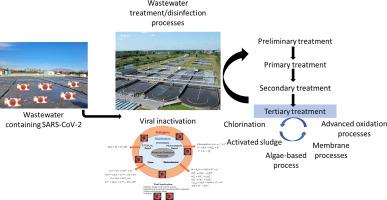Journal of Water Process Engineering ( IF 6.3 ) Pub Date : 2022-08-17 , DOI: 10.1016/j.jwpe.2022.103077 Milad Mousazadeh 1, 2 , Işık Kabdaşlı 3 , Sara Khademi 4 , Miguel Angel Sandoval 5, 6 , Seyedeh Parvin Moussavi 7 , Fatemeh Malekdar 8 , Vishakha Gilhotra 9 , Marjan Hashemi 10 , Mohammad Hadi Dehghani 11, 12

|
The COVID-19 epidemic has put the risk of virus contamination in water bodies on the horizon of health authorities. Hence, finding effective ways to remove the virus, especially SARS-CoV-2, from wastewater treatment plants (WWTPs) has emerged as a hot issue in the last few years. Herein, this study first deals with the fate of SARS-CoV-2 genetic material in WWTPs, then critically reviews and compares different wastewater treatment methods for combatting COVID-19 as well as to increase the water quality. This critical review sheds light the efficiency of advanced oxidation processes (AOPs) to inactivate virus, specially SARS-CoV-2 RNA. Although several physicochemical treatment processes (e.g. activated sludge) are commonly used to eliminate pathogens, AOPs are the most versatile and effective virus inactivation methods. For instance, TiO2 is the most known and widely studied photo-catalyst innocuously utilized to degrade pollutants as well as to photo-induce bacterial and virus disinfection due to its high chemical resistance and efficient photo-activity. When ozone is dissolved in water and wastewater, it generates a wide spectrum of the reactive oxygen species (ROS), which are responsible to degrade materials in virus membranes resulting in destroying the cell wall. Furthermore, electrochemical advanced oxidation processes act through direct oxidation when pathogens react at the anode surface or by indirect oxidation through oxidizing species produced in bulk solution. Consequently, they represent a feasible choice for the inactivation of a wide range of pathogens. Nonetheless, there are some challenges with AOPs which should be addressed for application at industrial-scale.
中文翻译:

对 COVID-19 时代现有废水处理方法的批判性回顾:高级氧化工艺在对抗病毒尤其是 SARS-CoV-2 方面有何潜力?
COVID-19 疫情让卫生当局开始关注水体中病毒污染的风险。因此,寻找有效的方法从废水处理厂(WWTP)中去除病毒,尤其是 SARS-CoV-2,已成为过去几年的热点问题。在此,本研究首先探讨了污水处理厂中 SARS-CoV-2 遗传物质的命运,然后批判性地回顾和比较了对抗 COVID-19 以及提高水质的不同废水处理方法。这篇重要评论揭示了高级氧化过程 (AOP) 灭活病毒(特别是 SARS-CoV-2 RNA)的效率。尽管通常使用多种物理化学处理工艺(例如活性污泥)来消除病原体,但 AOP 是最通用、最有效的病毒灭活方法。例如,TiO 2是最著名和广泛研究的光催化剂,由于其高耐化学性和高效的光活性,可无毒地用于降解污染物以及光诱导细菌和病毒消毒。当臭氧溶解在水和废水中时,会产生多种活性氧 (ROS),这些活性氧会降解病毒膜中的材料,从而破坏细胞壁。此外,当病原体在阳极表面反应时,电化学高级氧化过程通过直接氧化起作用,或者通过本体溶液中产生的氧化物质通过间接氧化起作用。因此,它们代表了灭活多种病原体的可行选择。尽管如此,AOP 仍存在一些在工业规模应用中应解决的挑战。











































 京公网安备 11010802027423号
京公网安备 11010802027423号